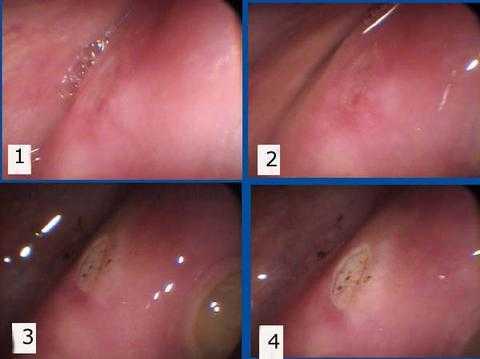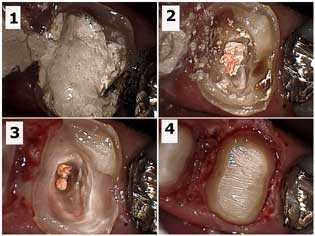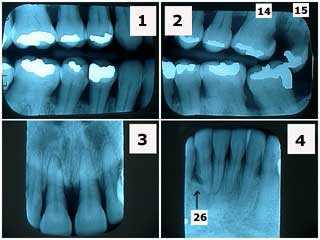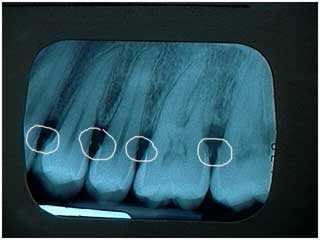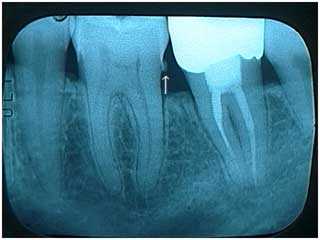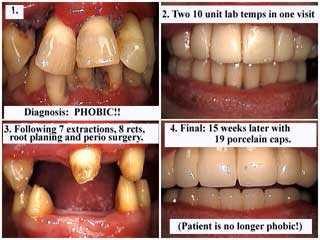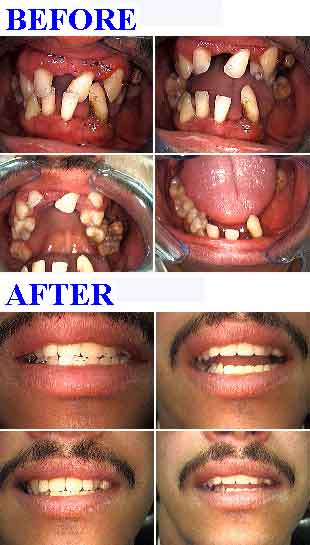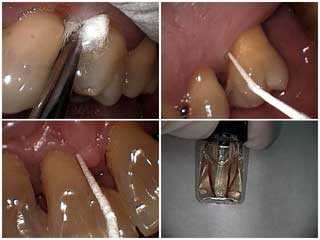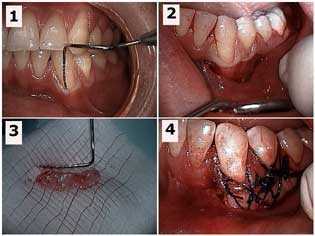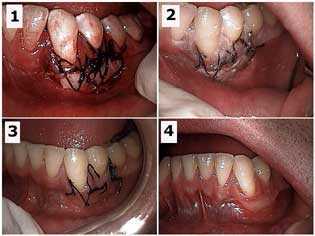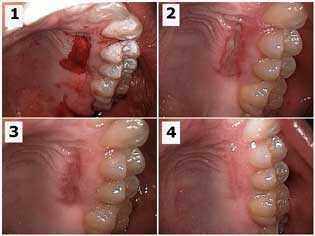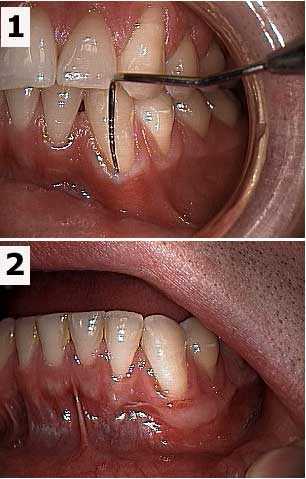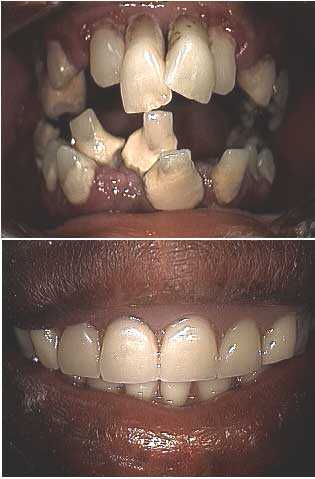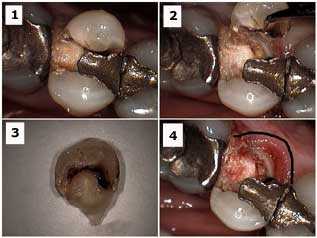Before and after photos on gum treatment includes fibromas and canker sores performed in our Gum Disease Treatment office.
Fibroma. This was identified during a routine exam and was referred to an Oral Surgeon for diagnosis and excisional biopsy. Always refer to a specialist for this type of diagnosis.
Treatment of a Canker Sore. 1) and 2) Pre-op images inside the cheek. 3) and 4) After chemical burn induced by sulfuric acid and sulfonated phenols in an aqueous solution.
Periodontal crown lengthening gum surgery. Dental crown buildup after root canal therapy of a broken molar that had a big tooth cavity. 1) Temporary dental filling material is in the tooth following root canal therapy. 2) Gutta percha exposed in the pulp chamber after removal of the temporary filling. Tooth decay is still present. 3) Decay removal and preparation into the canal orifices to aid in mechanical retention of the composite resin dental bonding core. 4) Final preparation after gum surgery in the distal section of the tooth.
Severe periodontal disease in a 40-year-old dental fear phobia patient. Note the severe horizontal bone loss in the x-rays and the lack of radiographic calculus. Tooth #26, adjacent to the vertical bony defect, is probably hopeless. This patient was treated with two rounds of scaling and root planing then was reevaluated by the Periodontist. Tooth #15 was extracted and #14 had root canal therapy and a dental crown.
Periodontal gum disease diagnosis in a pregnant patient in the seventh month of pregnancy. Radiographic calculus. Calculus is plaque that becomes hardened by absorbing salivary calcium and then becomes evident on x-rays. It is usually results from the chronic presence of dental plaque and is not healthy because it actually contains a colony of bacteria growing within it. A dental prophylaxis – teeth cleaning is a first step. Scaling and root planing is usually next followed by reevaluation with the Periodontist.
Periodontal disease treatment. Radiographic x-ray calculus. Calculus is plaque that becomes hardened by absorbing salivary calcium and then becomes evident on dental x-rays. It is associated with the chronic presence of teeth plaque and is not healthy. A dental cleaning, and then possibly scaling and root planing, is usually indicated followed by a Periodontist reevaluation.
Periodontics in Full Mouth Oral Reconstruction:
Diagnosis: Dental Fear Phobia.
Treatment: 7 teeth extractions, 8 teeth root canal therapy with composite resin cores, full mouth scaling and then periodontal gum surgery consisting of open flap debridement, 19 teeth of porcelain dental crowns over 8 abutments. Treatment time – 15 weeks. Most of that time was waiting for periodontal healing before making the final dental crowns.
Severe periodontal gum disease in a 35 year old male. Treat the dental fear and then the dentistry becomes easy. Gum disease of this magnitude in a pregnant patient could have a negative impact on a developing fetus. Women anticipating pregnancy should consider completing needed dentistry before conception to avoid their own potential emergencies and to have a healthier child.
Short clinical crowns of these teeth require crown lengthening periodontal gum surgery to increase retention for the maxillary anterior teeth bridge. 1) and 2) A three millimeter submarginal incision was made around all the teeth. 3) The gingival collar of gum tissue was removed including the interproximal tissue. 4) The periodontal gum flap was sutured – stitched – against the underlying jaw bone.
Periodontal culture to test for the presence of periodontal pathogens bacteria. Some of the species of bacteria that are a concern to the gums include: spirochetes, porphyromonas gingivalis and actinobacillus actinomycetemcomitans.
How to perform a periodontal oral microbiology culture. First use a cotton pellet and a college pliers to wipe away supragingival plaque. Place a medium cotton point – from endodontics – into about six different sites with the deepest periodontal pocket probings. Leave the cotton point in place for five to ten seconds and then quickly place it in the culture medium. Ship overnight to the Microbiologic Testing Lab at Temple University in Philadelphia.
Free gingival graft for a mandibular canine tooth. 1) Periodontal probe in the gingival sulcus showing the mucogingival defect. 2) Initial subsulcular gingival incision. 3) The gingival tissue gums harvested from the palate that will be used for the gum graft. 4) The free gingival graft sutured – stitched – in place. Photo #1 of 4.
Free gingival graft for a mandibular canine tooth. How to Pictures. Healing of the recipient site. Photo 1) Initial surgical site. Photo 2) One week post-op. Photo 3) Two weeks post-op. Photo 4) Seven weeks post-op. Photo #2 of 4.
Free gingival graft for a mandibular canine tooth. How to pictures. Healing of the palatal donor site. Photo 1) Initial surgical site. Photo 2) One week post-op. Photo 3) Two weeks post-op. Photo 4) Seven weeks post-op. Photo #3 of 4.
Before and after pictures of a free gingival gum graft of a mandibular canine tooth. Photo 1) Periodontal probe in the gingival sulcus shows the mucogingival defect. Photo 2) Seven weeks post-op. Photo #4 of 4.
Periodontal therapy – gum disease treatment – in a full mouth oral reconstruction of a dental phobia anxiety patient. These pictures and panoramic x-ray show the initial visit. It is important to determine what teeth, if any, may be periodontally saved at least temporarily. It is easier for a patient to emotionally adjust to a temporary dental prosthesis that has at least some amount of retention provided by natural tooth abutments. The teeth chosen were #6, 11, 22 and 28. The decision to fabricate a removable immediate partial denture, rather than a fixed lab-processed temporary dental bridge, was determined by the particular weakness of tooth #28. The patient was informed that the immediate prosthesis was to be used for the healing phase and that the four remaining abutments, particularly #28, might be subsequently extracted. Photo #1 of 2.
Periodontal therapy – gum disease treatment – in a full mouth oral reconstruction of a dental phobia anxiety patient. Before and after pictures: two visits. Photo #2 of 2.
Periodontal treatment of a broken tooth. 1) The entire lingual cusp of this upper premolar tooth broken and can be seen separated from the tooth decay around the silver dental filling. 2) The lingual cusp is being lifted away from the tooth. 3) The fractured cusp of the tooth after it was removed. 4) The tooth after the removal of the fractured cusp. The black line indicates the anticipated extent of crown lengthening periodontal gum surgery that will be needed.

